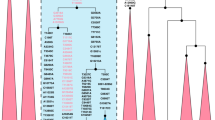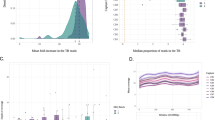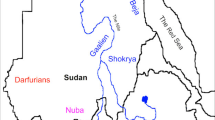Abstract
Human Y chromosomes belonging to the haplogroup R1b1-P25, although very common in Europe, are usually rare in Africa. However, recently published studies have reported high frequencies of this haplogroup in the central-western region of the African continent and proposed that this represents a ‘back-to-Africa’ migration during prehistoric times. To obtain a deeper insight into the history of these lineages, we characterised the paternal genetic background of a population in Equatorial Guinea, a Central-West African country located near the region in which the highest frequencies of the R1b1 haplogroup in Africa have been found to date. In our sample, the large majority (78.6%) of the sequences belong to subclades in haplogroup E, which are the most frequent in Bantu groups. However, the frequency of the R1b1 haplogroup in our sample (17.0%) was higher than that previously observed for the majority of the African continent. Of these R1b1 samples, nine are defined by the V88 marker, which was recently discovered in Africa. As high microsatellite variance was found inside this haplogroup in Central-West Africa and a decrease in this variance was observed towards Northeast Africa, our findings do not support the previously hypothesised movement of Chadic-speaking people from the North across the Sahara as the explanation for these R1b1 lineages in Central-West Africa. The present findings are also compatible with an origin of the V88-derived allele in the Central-West Africa, and its presence in North Africa may be better explained as the result of a migration from the south during the mid-Holocene.
Similar content being viewed by others
Log in or create a free account to read this content
Gain free access to this article, as well as selected content from this journal and more on nature.com
or
References
Jobling MA, Tyler-Smith C : The human Y chromosome: an evolutionary marker comes of age. Nat Rev Genet 2003; 4: 598–612.
Batini C, Ferri G, Destro-Bisol G et al: Signatures of the preagricultural peopling processes in sub-saharan africa as revealed by the phylogeography of early Y chromosome lineages. Mol Biol Evol 2011; 28: 2603–2613.
Gomes V, Sánchez-Diz P, Amorim A et al: Digging deeper into East African human Y chromosome lineages. Hum Genet 2010; 127: 603–613.
Cruciani F, Trombetta B, Massaia A et al: A revised root for the human Y chromosomal phylogenetic tree: the origin of patrilineal diversity in Africa. Am J Hum Genet 2011; 88: 814–818.
Berniell-Lee G, Calafell F, Bosch E et al: Genetic and demographic implications of the Bantu expansion: insights from human paternal lineages. Mol Biol Evol 2009; 26: 1581–1589.
Cruciani F, Santolamazza P, Shen P et al: A back migration from Asia to sub-Saharan Africa is supported by high-resolution analysis of human Y-chromosome haplotypes. Am J Hum Genet 2002; 70: 1197–1214.
Cruciani F, Trombetta B, Sellitto D et al: Human Y chromosome haplogroup R-V88: a paternal genetic record of early mid Holocene trans-Saharan connections and the spread of Chadic languages. Eur J Hum Genet 2010; 18: 800–807.
Blench R : Archaeology, Language, and the African Past. Oxford, UK: Altamira Press, 2006.
Ehret C : The Civilizations of Africa: A History to 1800. Oxford, UK: University of Virginia Press, 2002.
Cruciani F, Trombetta B, Sellitto D et al: Chadic languages and Y haplogroups Reply. Eur J Hum Genet 2010; 18: 1186–1187.
Lancaster A : Chadic languages and Y haplogroups. Eur J Hum Genet 2010; 18: 1185–1185.
The World Factbook: in:: Central Intelligence Agency. Washington, DC, 2009.
Lewis MP : Ethnologue: Languages of the World 6th edn Online version http://www.ethnologue.com/SIL. International: Dallas, TX, 2009.
Lareu MV, Phillips CP, Carracedo A et al: Investigation of the STR locus HUMTH01 using PCR and two electrophoresis formats: UK and Galician Caucasian population surveys and usefulness in paternity investigations. Forensic Sci Int 1994; 66: 41–52.
Gusmão L, Butler JM, Carracedo A et al: DNA Commission of the International Society of Forensic Genetics (ISFG): an update of the recommendations on the use of Y-STRs in forensic analysis. Int J Legal Med 2006; 120: 191–200.
Arroyo-Pardo E, Gusmão L, López-Parra AM et al: Genetic variability of 16 Y-chromosome STRs in a sample from Equatorial Guinea (Central Africa). Forensic Sci Int 2005; 149: 109–113.
Karafet TM, Mendez FL, Meilerman MB et al: New binary polymorphisms reshape and increase resolution of the human Y chromosomal haplogroup tree. Genome Res 2008; 18: 830–838.
Beleza S, Gusmão L, Amorim A et al: The genetic legacy of western Bantu migrations. Hum Genet 2005; 117: 366–375.
Hassan HY, Underhill PA, Cavalli-Sforza LL et al: Y-chromosome variation among sudanese: restricted gene flow, concordance with language, geography, and history. Am J Phys Anthropol 2008; 137: 316–323.
Semino O, Santachiara-Benerecetti AS, Falaschi F et al: Ethiopians and Khoisan share the deepest clades of the human Y-chromosome phylogeny. Am J Hum Genet 2002; 70: 265–268.
Tishkoff SA, Gonder MK, Henn BM et al: History of click-speaking Populations of Africa inferred from mtDNA and Y chromosome genetic variation. Mol Biol Evol 2007; 24: 2180–2195.
Underhill PA, Passarino G, Lin AA et al: The phylogeography of Y chromosome binary haplotypes and the origins of modern human populations. Ann Hum Genet 2001; 65: 43–62.
Brión M, Sobrino B, Blanco-Verea A et al: Hierarchical analysis of 30 y-chromosome SNPs in European populations. Int J Legal Med 2005; 119: 10–15.
Excoffier L, Lischer HE : Arlequin suite ver 3.5: a new series of programs to perform population genetics analyses under Linux and Windows. Mol Ecol Resources 2010; 10: 564–567.
StatSoft Inc.: STATISTICA (data analysis software system), version 7, 2004.
Bandelt HJ, Forster P, Sykes BC et al: Mitochondrial portraits of human populations using median networks. Genetics 1995; 141: 743–753.
Bandelt HJ, Forster P, Rohl A : Median-joining networks for inferring intraspecific phylogenies. Mol Biol Evol 1999; 16: 37–48.
Qamar R, Ayub Q, Mohyuddin A et al: Y-chromosomal DNA variation in Pakistan. Am J Hum Genet 2002; 70: 1107–1124.
Luis JR, Rowold DJ, Regueiro M et al: The Levant versus the Horn of Africa: Evidence for bidirectional corridors of human migrations. Am J Hum Genet 2004; 74: 532–544.
Wood ET, Stover DA, Ehret C et al: Contrasting patterns of Y chromosome and mtDNA variation in Africa: evidence for sex-biased demographic processes. Eur J Hum Genet 2005; 13: 867–876.
Rosa A, Ornelas C, Jobling MA et al: Y-chromosomal diversity in the population of Guinea-Bissau: a multiethnic perspective. BMC Evol Biol 2007; 7: 124.
Cruciani F, La Fratta R, Santolamazza P et al: Phylogeographic analysis of haplogroup E3b (E-M215) y chromosomes reveals multiple migratory events within and out of Africa. Am J Hum Genet 2004; 74: 1014–1022.
Carvalho M, Brito P, Bento AM et al: Paternal and maternal lineages in Guinea-Bissau population. Forensic Sci Int Genet 2011; 5: 114–116.
Coelho M, Sequeira F, Luiselli D et al: On the edge of Bantu expansions: mtDNA, Y chromosome and lactase persistence genetic variation in southwestern Angola. BMC Evol Biol 2009; 9: 80.
Gomes V, Alves C, Amorim A et al: Nilotes from Karamoja, Uganda: Haplotype data defined by 17 Y-chromosome STRs. Forensic Sci Int Genet 2010; 4: E83–E86.
Willuweit S, Roewer L : Y chromosome haplotype reference database (YHRD): update. Forensic Sci Int Genet 2007; 1: 83–87.
Hurles ME, Nicholson J, Bosch E et al: Y chromosomal evidence for the origins of oceanic-speaking peoples. Genetics 2002; 160: 289–303.
Slatkin M : A measure of population subdivision based on microsatellite allele frequencies. Genetics 1995; 139: 457–462.
Semino O, Passarino G, Oefner PJ et al: The genetic legacy of paleolithic Homo sapiens sapiens in extant Europeans: a Y chromosome perspective. Science 2000; 290: 1155–1159.
Wells RS, Yuldasheva N, Ruzibakiev R et al: The Eurasian Heartland: A continental perspective on Y-chromosome diversity. Proc Natl Acad Sci USA 2001; 98: 10244–10249.
Balaresque P, Bowden GR, Adams SM et al: A predominantly neolithic origin for European paternal lineages. PLoS Biol 2010; 8: e1000285.
Busby GB, Brisighelli F, Sanchez-Diz P et al: The peopling of Europe and the cautionary tale of Y chromosome lineage R-M269. Proc Biol Sci Royal Soc 2012; 279: 884–892.
Myres NM, Rootsi S, Lin AA et al: A major Y-chromosome haplogroup R1b Holocene era founder effect in Central and Western Europe. Eur J Hum Genet 2011; 19: 95–101.
Plaza S, Salas A, Calafell F et al: Insights into the western Bantu dispersal: mtDNA lineage analysis in Angola. Hum Genet 2004; 115: 439–447.
Vansina J : New linguistic evidence and the Bantu Expansion. J Afr Hist 1995; 36: 173–195.
Cerny V, Pereira L, Musilova E et al: Genetic Structure of Pastoral and Farmer Populations in the African Sahel. Mol Biol Evol 2011; 28: 2491–2500.
Acknowledgements
This work was supported by the Fundação para a Ciência e Tecnologia through a PhD grant SFRH/BD/36045/2007. IPATIMUP is an Associate Laboratory of the Portuguese Ministry of Science, Technology and Higher Education and is partially supported by FCT, the Portuguese Foundation for Science and Technology.
Author information
Authors and Affiliations
Corresponding author
Ethics declarations
Competing interests
The authors declare no conflict of interest.
Additional information
Supplementary Information accompanies the paper on European Journal of Human Genetics website
Supplementary information
Rights and permissions
About this article
Cite this article
González, M., Gomes, V., López-Parra, A. et al. The genetic landscape of Equatorial Guinea and the origin and migration routes of the Y chromosome haplogroup R-V88. Eur J Hum Genet 21, 324–331 (2013). https://doi.org/10.1038/ejhg.2012.167
Received:
Revised:
Accepted:
Published:
Issue date:
DOI: https://doi.org/10.1038/ejhg.2012.167
Keywords
This article is cited by
-
Searching for the roots of the first free African American community
Scientific Reports (2020)
-
The peopling of the last Green Sahara revealed by high-coverage resequencing of trans-Saharan patrilineages
Genome Biology (2018)



